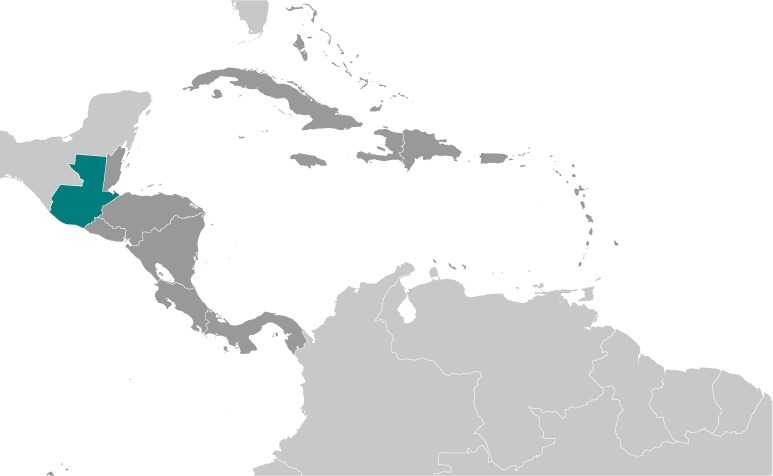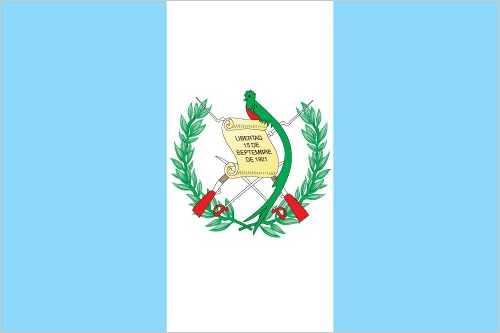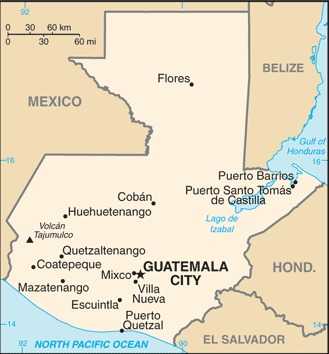Introduction
Background
The Maya civilization flourished in Guatemala and surrounding regions during the first millennium A.D. After almost three centuries as a Spanish colony, Guatemala won its independence in 1821. During the second half of the 20th century, it experienced a variety of military and civilian governments, as well as a 36-year guerrilla war that ended in 1996.
Geography
Area
total: 108,889 sq km
land: 107,159 sq km
water: 1,730 sq km
Climate
tropical; hot, humid in lowlands; cooler in highlands
Natural resources
petroleum, nickel, rare woods, fish, chicle, hydropower
People and Society
Population
total: 18,255,216
male: 9,050,684
female: 9,204,532 (2024 est.)
Ethnic groups
Mestizo (mixed Indigenous-Spanish - in local Spanish called Ladino) 56%, Maya 41.7%, Xinca (Indigenous, non-Maya) 1.8%, African descent 0.2%, Garifuna (mixed West and Central African, Island Carib, and Arawak) 0.1%, foreign 0.2% (2018 est.)
Languages
Spanish (official) 69.9%, Maya languages 29.7% (Q'eqchi' 8.3%, K'iche 7.8%, Mam 4.4%, Kaqchikel 3%, Q'anjob'al 1.2%, Poqomchi' 1%, other 4%), other 0.4% (includes Xinca and Garifuna); note - the 2003 Law of National Languages officially recognized 23 indigenous languages, including 21 Maya languages, Xinca, and Garifuna (2018 est.)
Religions
Evangelical 45.7%, Roman Catholic 42.4%, none 11%, unspecified 0.9% (2023 est.)
Population growth rate
1.49% (2024 est.)
Government
Government type
presidential republic
Capital
name: Guatemala City
Executive branch
chief of state: President Bernardo ARÉVALO de León (since 15 January 2024); Vice President Karin HERRERA (since 15 January 2024); note - the president is both chief of state and head of government
head of government: President Bernardo ARÉVALO de León (since 15 January 2024); Vice President Karin HERRERA (since 15 January 2024)
Legislative branch
description: unicameral Congress of the Republic or Congreso de la Republica (160 seats; 128 members directly elected in multi-seat constituencies in the country's 22 departments and 32 directly elected in a single nationwide constituency by closed party-list proportional representation vote, using the D'Hondt method; members serve 4-year terms)
Economy
Economic overview
developing Central American economy; steady economic growth fueled by remittances; high poverty and income inequality; limited government services, lack of employment opportunities, and frequent natural disasters impede human development efforts and drive emigration
Real GDP (purchasing power parity)
$159.034 billion (2022 est.)
$152.744 billion (2021 est.)
$141.426 billion (2020 est.)
Real GDP per capita
$9,200 (2022 est.)
$8,900 (2021 est.)
$8,400 (2020 est.)
Agricultural products
sugarcane, bananas, oil palm fruit, maize, cantaloupes/melons, potatoes, milk, tomatoes, chicken, pineapples (2022)
Industries
sugar, textiles and clothing, furniture, chemicals, petroleum, metals, rubber, tourism
Exports
$18.127 billion (2022 est.)
$15.246 billion (2021 est.)
$12.713 billion (2020 est.)
Exports - partners
US 32%, El Salvador 12%, Honduras 10%, Nicaragua 6%, Mexico 4% (2022)
Exports - commodities
garments, coffee, bananas, palm oil, raw sugar (2022)
Imports
$33.938 billion (2022 est.)
$27.343 billion (2021 est.)
$19.267 billion (2020 est.)
Imports - partners
US 34%, China 18%, Mexico 9%, El Salvador 4%, Costa Rica 3% (2022)
Imports - commodities
refined petroleum, video displays, paper, plastic products, cars (2022)
Exchange rates
quetzales (GTQ) per US dollar -
Exchange rates:
7.748 (2022 est.)
7.734 (2021 est.)
7.722 (2020 est.)
7.697 (2019 est.)
7.519 (2018 est.)
Page last updated: Thursday, May 30, 2024




